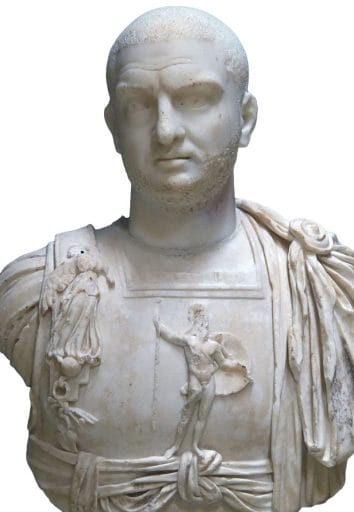Last Updated on December 25, 2021 by Vladimir Vulic
Life: AD c. 206 – 253

- Name: Gaius Vibius Afininus Trebonianus Gallus
- Born AD ca. 206.
- Consul AD 245.
- Became emperor in June AD 251.
- Wife: Afinia Gemina Baebiana (one son; Gaius Vibius Volusianus; one daughter; Vibia Galla).
- Died at Interamna, August AD 253.
Gaius Vibius Afininus Trebonianus Gallus was born around AD 206 into an old Etruscan family from Perusia.
He was consul in AD 245 and later was made governor of Upper and Lower Moesia. With the Gothic invasions of AD 250, Gallus became a major figure in the Gothic wars of emperor Decius.
Many blamed Gallus for the eventual defeat of Decius, claiming he had betrayed his emperor by secretly working with the Goths to see Decius killed. But there is little one can see today which would justify such allegations.
After the disastrous battle of Abrittus, Trebonianus Gallus was hailed was proclaimed emperor by his soldiers (AD 251).
His first act as emperor though was deeply unpopular. No doubt eager to get to Rome and secure his throne, he made a very costly peace with the Goths. The barbarians were not only permitted to return home with all their plunder, even with their Roman prisoners. But Gallus even agreed to pay them an annual subsidy in order for them not to attack again.
Gallus then quickly marched back to Rome, hoping to secure his position by assuring good relations with the senate. He also took great care to show respect for Decius and his fallen son, ensuring their deification.
Decius’ younger son Hostilianus, still too young to rule himself, was adopted and raised to the rank of Augustus to stand alongside Gallus as his imperial colleague.
In order not to affront Decius’ widow, Gallus did not elevate his own wife, Baebiana, to the rank of Augusta.
Though Gallus’ son Gaius Vibius Volusianus was duly given the title of Caesar.
Shortly after Hostilianus died and Volusianus was elevated to co-Augustus in his place.
Gallus’ reign should suffer from a series of disasters, worst of which was a terrible plague which ravaged the empire for over a decade. One of the first victims of the disease had been the young emperor Hostilianus. The pestilence depleted the population and all but crippled the army, just when new, grave threats emerged on the frontiers. And so Gallus could do little as the Persians under Sapor I (Shapur I) overran Armenia, Mesopotamia and Syria (AD 252). Almost as powerless was he to prevent the Goths from terrifying the Danubian provinces and even raiding and devastating the northern shoreline of Asia Minor (Turkey).
Gallus, eager to find a means by which to distract attention from these grave dangers to the empire, revived the persecution of the Christians. Pope Cornelius was thrown into prison and died in captivity. But also other measures were taken in order to win favour. By creating a scheme by which even the very poor were entitled to a decent burial, he won much goodwill from ordinary people.
But in such troubled times it was only a matter of time before a challenger to the throne should emerge. In AD 253 Marcus Aemilius Aemilianus, governor of Lower Moesia, launched a successful attack on the Goths. His soldiers, seeing in him a man who at last could achieve victory over the barbarians, elected him emperor.
Aemilian immediately marched south with his armies and crossed the mountains into Italy.
Gallus and Volusianus were taken by complete surprise it appears. They gathered what few troops they could, called upon Publius Licinius Valerianus on the Rhine to come to their aid with the German legions, and moved north toward the approaching Aemilian.
Though with no help possibly being able to arrive in time from Valerian, while faced with Aemilian’s clearly superior Danubian troops, Gallus’ soldiers did the only thing they could in order to avoid being slaughtered. They turned on their two emperors near Interamna and killed them both (August AD 253).

Historian Franco Cavazzi dedicated hundreds of hours of his life to creating this website, roman-empire.net as a trove of educational material on this fascinating period of history. His work has been cited in a number of textbooks on the Roman Empire and mentioned on numerous publications such as the New York Times, PBS, The Guardian, and many more.
